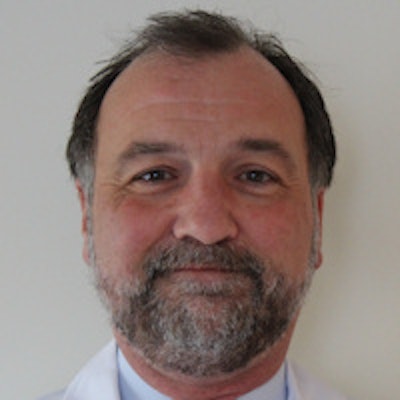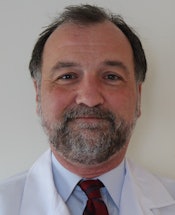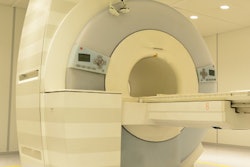
Many radiologists report working longer hours for less reimbursement with decreasing job satisfaction. Few practices have implemented a business strategy to correct this seemingly inexorable path of more work for less pay.
One solution is to incorporate existing skilled radiology team members to enhance interpretative service. Adding advanced radiology clinical provider employees can also achieve the goal of being more competitive in the market. I discuss below the strategies which are available to maximize efficiency and quality.
 Dr. Nicolas Argy.
Dr. Nicolas Argy.What does the radiologist face today? CT has moved from dozens of images in the axial plane to hundreds if not thousands of images in a multiplanar and 3D display. MRI has gone from a few sequences with hundreds of images to dozens of sequences with thousands of images.
Increasing complexity and time needed for accurate diagnosis are all demanded within the framework of shrinking reimbursement. Time constraints constantly pressure radiologists to be more productive without losing accuracy. Value-based reimbursement and new measures of quality have increased the need to be highly efficient in the delivery of radiology services.
The most successful practices have used the tremendous resources within the department to enhance accuracy and productivity. The traditional workflow for ultrasound provides a model for success. Ultrasonography practice has used its technologists to document their work through the tech worksheet. Radiologists often use the worksheet as a template for their reports. Rather than using a separate formatted ultrasound report or dictating de novo, the radiologist can review the sonologists' preliminary findings while interpreting the images and modify as necessary.
A local Boston practice uses software that formats the tech worksheet into a preliminary report; if, after reviewing the images, the radiologist agrees, then he or she just "signs" the report. No dictation and no editing are needed for more than 80% of their studies.
Opportunities in advanced imaging
Another opportunity to take advantage of the skill and expertise of the radiology team is in advanced imaging of CT and MRI. The most seasoned and experienced CT and MRI technologists can identify very subtle and significant findings while performing the study and bring these to the attention of the radiologist.
Another Massachusetts practice has its technologists use a checklist of the anatomy covered and identify possible abnormalities. Having the technologists document their initial quality control assessment of images provides an opportunity for a second set of eyes to identify regions of interest warranting further scrutiny. Working cooperatively, the CT or MRI tech can enhance the accuracy and efficiency of the interpreting radiologist.
Another approach that has been successful in improving radiologist productivity is using radiologist assistants (RAs) to perform fluoroscopy and minor special procedures, under the supervision of an attending radiologist. The advantages are clear. By using dedicated RA personnel, the majority of fluoroscopy and minor special procedures can be performed by a limited number of practitioners, which typically enhances skills and efficiency. One practice calculated the yearly savings to be over $500,000.
So often, general radiologists are rotated in and out of fluoro or minor special procedures, thereby diluting their experience and proficiency. While not delving into the quagmire of what billing can be done by an RA or the supervising radiologist, if the presence of an advanced care provider will free up 1.0 full-time equivalent (FTE) radiologist, their inclusion in workflow provides an excellent return on investment.
An academic program in the northeastern U.S. uses advanced care radiology practitioners to aid in drafting preliminary reports like residents or fellows across all modalities. Using the RA to "scribe" a preliminary report eliminates the formatting and clerical function often assumed by the radiologist and can save many hours.
A metropolitan Boston practice calculated that if it reduced each radiologist's time by 60 seconds per report by using scribing or templates, it would save 10 hours of radiologist time per day for the practice. The small incremental efficiencies add up quickly and have both dramatic financial and quality impact. The RA in another northeastern practice would protocol all CT and MRI exams and save the radiologist up to two hours a day of work and avoided phone calls.
Some radiology practices use mammography technologists, all of whom perform quality control review of their images, to identify potential areas of concern and direct the radiologist's attention to these regions. The large rate of both false-positive and false-negative results using computer-aided detection (CAD) in mammography has frustrated many radiologists. A seasoned technologist can frequently offer more-useful guidance.
There is no doubt that a well-trained advanced care provider in radiology can provide a preliminary review of screening mammography and generate a draft report which would enormously aid both the radiologist and ultimately the patient with increasing efficiency and accuracy. Using the RA to "scribe" a preliminary report eliminates the formatting and clerical function often assumed by the radiologist and can save many hours a day.
The path to high-quality care
Nothing in the strategies above should be construed as permitting or allowing nonradiologists to interpret examinations. The final interpretation rests solely with the radiologist whose signature appears at the bottom of the report.
As all radiologists are aware from the start of the use of diagnostic imaging, technologists have always done quality control review of their images. By virtue of experience and having seen the patient, seasoned technologists can direct the radiologist to areas of concern. All radiologists have benefited from the technologist identifying the point of maximum direct tenderness on a plain film of a bone, which has corrected the original conclusion of a vascular channel in the cortex to more likely a hairline fracture.
Utilizing the existing valuable skills of the imaging team and building them into the daily routine can increase both productivity and accuracy in image interpretation. Hiring the expertise of an RA also is an excellent path to high quality, with greater efficiency and profitability.
Using these proven techniques, sequential and incremental business strategies drafted by the practice business manager or consultant and subsequently approved by the radiologists are a path to high-quality, value-based, efficient and profitable imaging care.
Dr. Nicolas Argy, JD, practiced radiology for 30 years. He is currently a healthcare consultant, educator, and lecturer on medicolegal topics. He can be reached at [email protected].
The comments and observations expressed herein are those of the author and do not necessarily reflect the opinions of AuntMinnie.com.



















